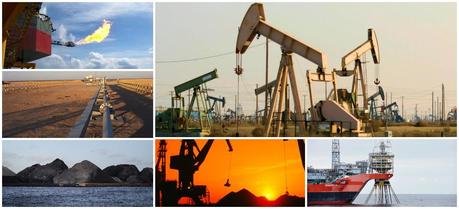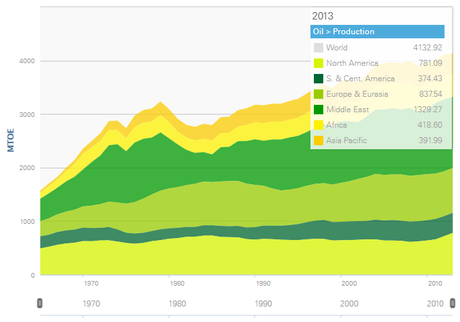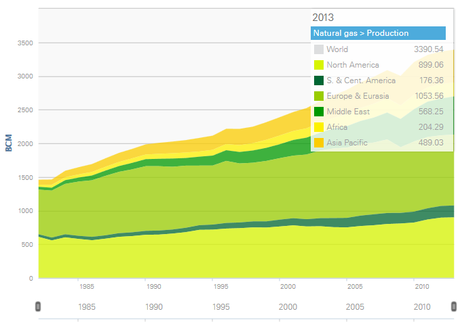 BP Statistical Review of World Energy 2014: Global primary energy consumption increased by 2.3% in 2013, growing faster than in 2012.
BP Statistical Review of World Energy 2014: Global primary energy consumption increased by 2.3% in 2013, growing faster than in 2012.The BP Statistical Review of World Energy 2014, launched this week in Moscow, reflects how shifts in energy consumption mirror those in the world’s economic patterns.
According to BP, global energy demand accelerated in 2013 but, reflecting the weakness of the global economy, growth of 2.3% remained slightly below the historical average. Energy consumption in the emerging economies grew below their long-term average rate, rising by 3.1%, driven by slower growth in China. However, consumption in the mature economies of the OECD grew by a higher-than-average rate of 1.2%—entirely as a result of strong growth in the United States. As a result the gap between growth in the OECD and non-OECD narrowed to levels not seen since 2000.
SEE ALSO: IEA: Unconventional Oil Revolution to Expand Beyond North America

World oil production increased by just 560,000 b/d in 2013, less than half the growth of global consumption. (Credit: BP / Statistical Review of World Energy 2014)
Nonetheless, the emerging economies continue to dominate the growth in global energy demand, accounting for 80% of growth last year and nearly 100% of growth over the past decade.
The BP Statistical Review of World Energy 2014—the publication’s 63rd annual edition—also illustrates how geopolitical events in a number of countries continued to impact oil production in 2013, with Libya suffering the largest single decline in the face of renewed civil unrest. Those disruptions, however, were offset by a big increase in oil production in the US—driven by the massive investment in production from shale and other ‘tight’ formations. As a net result, average oil prices remained unusually stable—albeit at levels exceeding $100 per barrel for a third consecutive year.
Speaking at the publication’s launch in Moscow, BP Group Chief Executive Bob Dudley said: “The Review again demonstrates the strength of the flexible global energy system in adapting to a changing world. The major disruptions to production seen throughout 2013 were balanced by continued rises in production elsewhere. This underlines the importance of continuing to secure these new supplies through continued access to new resources, policies to encourage markets and investment, and the application of new technologies worldwide.”
The developments also highlighted the critical importance of both policy and market forces in delivering new supplies. As BP Chief Economist Christof Rühl also noted, “The huge investments seen in the U.S. have been encouraged and enabled by a favorable policy regime. And this has resulted in the U.S. delivering the world’s largest increase in oil production last year. Indeed, the US increase in 2013—up by 1.1 million barrels a day—was one of the biggest annual oil production increases the world has ever seen.”

World natural gas production increased by 1.1% in 2013, slightly below the growth rate of global consumption (+1.4%). (Credit: BP / Statistical Review of World Energy 2014)
Elsewhere, the impact of policy on energy was also seen in continued robust growth in renewable energy—albeit from a low base. Renewables now account for more than 5% of global power output and, including biofuels, for nearly 3% of primary energy consumption. However, the challenge of sustaining expensive subsidy regimes has become visible where penetration rates are highest, namely in the below-average growth of Europe’s leading renewable producers, who are grappling with weak economic growth and strained budgets.
Review highlights:
- Global primary energy consumption increased by 2.3% in 2013, growing faster than in 2012 (+1.8%) but below the 10-year average of 2.5%.
- All fuels except oil, nuclear power and renewables in power generation grew at below-average rates.
- Growth was below average for all regions except North America.
- Oil remains the world’s leading fuel, with 32.9% of global energy consumption, but it lost market share for the 14th consecutive year and its current market share is once again the lowest in our data set, going back to 1965.
- Emerging economies accounted for 80% of the global increase in energy consumption—even though growth in these countries was a below average 3.1%. OECD consumption rose by an above-average 1.2%.
- Robust US growth (+2.9%) accounted for all of the net increase in the OECD and consumption in the EU and Japan fell by 0.3% and 0.6%, respectively.
- Global oil consumption grew by 1.4 million barrels per day (b/d), or 1.4%—just above the historical average.
- Countries outside the OECD now account for the majority (51%) of global oil consumption and they once again accounted for all of the net growth in global consumption. OECD consumption declined by 0.4%, the seventh decrease in the past eight years.
- Global oil production did not keep pace with the growth in global consumption, rising by just 560,000 b/d or 0.6%. The US (+1.1 million b/d) recorded the largest growth in the world and the largest annual increment in the country’s history for a second consecutive year.
- Global proved reserves of oil increased to 1687.9 billion barrels at the end of 2013, sufficient to meet 53.3 years of global production.
- World natural gas consumption grew by 1.4%, below the historical average of 2.6%. As with primary energy, consumption growth was above average in the OECD countries (+1.8%) and below average outside the OECD (+1.1%).
- India (-12.2%) recorded the largest volumetric decline in the world, while EU gas consumption fell to the lowest level since 1999.
- Globally, natural gas accounted for 23.7% of primary energy consumption.
- Global proved reserves of natural gas increased to 185.7 trillion cubic meters (tcm), sufficient to meet 54.8 years of global production.
- Coal consumption grew by 3% in 2013, well below the 10-year average of 3.9% but it is still the fastest-growing fossil fuel.
- Coal’s share of global primary energy consumption reached 30.1%, the highest since 1970.
- Global nuclear output grew by 0.9%, the first increase since 2010. Nuclear output accounted for 4.4% of global energy consumption, the smallest share since 1984.
- Global hydroelectric output grew by a below average 2.9%, and accounted for 6.7% of global energy consumption.
- Renewable energy sources—in power generation as well as transport—continued to increase in 2013, reaching a record 2.7% of global energy consumption, up from 0.8% a decade ago.
- Globally, wind energy (+20.7%) once again accounted for more than half of renewable power generation growth and solar power generation grew even more rapidly (+33%), but from a smaller base.
- Global biofuels production grew by a below-average 6.1% (80,000 b/doe), driven by increases in the two largest producers: Brazil and the US.
- For more than half of renewable power generation growth and solar power generation grew even more rapidly (+33%), but from a smaller base.
- Global biofuels production grew by a below-average 6.1% (80,000 ooooe), driven by increases in the two largest producers: Brazil and the US.
The BP Statistical Review of World Energy 2014 is available online.

